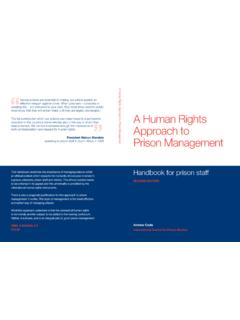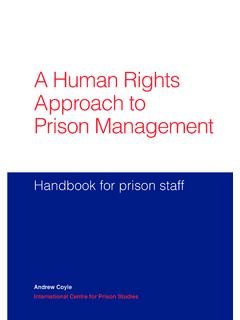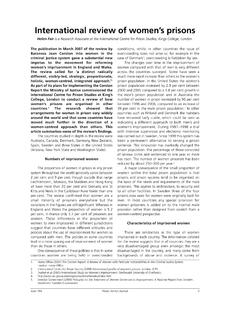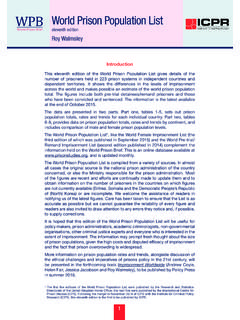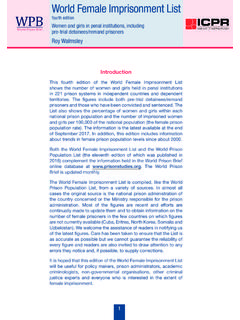Transcription of PRISON
1 IPRISONE vidence of its use and over-use from around the worldJessica JacobsonCatherine HeardHelen FairiiPrison: Evidence of its use and over-use from around the worldInstitute for Criminal Policy ResearchBirkbeck, University of London42 Store StreetLondon WC1E 7 DBEmail website PRISON Brief @icprtweet and @ICPSL ondonFair Trials5 Castle Road London NW1 8 PRWebsite @fairtrials 2017 Institute for Criminal Policy Research and the authorsThe rights of Jessica Jacobson, Catherine Heard and Helen Fair to be identified as the authors of this work has been asserted by them in accordance with the Copyright, Designs and Patents Act publication may be freely reviewed, abstracted or reproduced in part, but not for sale or for use in conjunction with any commercial purposes.
2 Any changes to the text of this publication must be approved in writing by the Institute for Criminal Policy Research. Due credit must be given to the Institute for Criminal Policy Research and to this publication. Enquiries should be addressed to document was produced with financial assistance from the Open Society Foundations. Its contents are the sole responsibility of the Institute for Criminal Policy Research and can under no circumstances be regarded as reflecting the position of the Open Society & print Foreword v Acknowledgments vi Summary vii1. Use and over-use of imprisonment worldwide 1 Patterns of imprisonment worldwide 1 The ten jurisdictions 22.
3 Some brief histories of the use of imprisonment 5 Kenya 5 South Africa 6 Brazil 8 The United States 11 India 13 Thailand 15 England and Wales 17 Hungary 19 The Netherlands 21 Australia 233. Learning from disparities in the use of imprisonment 25 Overview of use of imprisonment in the ten countries 25 New approaches to reducing resort to imprisonment 27 References 33 Appendix: The ten countries in their global context 38ivPrison: Evidence of its use and over-use from around the worldvForewordImagine you are accused of theft, drug trafficking or even murder. Would you be arrested by the police and detained before trial?
4 If convicted, would you go to PRISON ? How long for?Of course, the answers would depend in part on the offence you re accused of. But exactly the same alleged conduct would result in radically different responses depending on where in the world you happen to be and even, to some extent, on who you are. From the statistics in this report you can already make predictions about how you might fare: Imprisonment is simply a much more likely outcome in some countries than in others. The US is a well-known outlier, housing one fifth of the world s PRISON population. In 2008 its PRISON rate (the number of prisoners per 100,000 of the population) peaked at 755. By contrast, in India the PRISON rate is 33 and in the Netherlands it is 61.
5 There have been shocking changes over time, for example, in how readily you might be sentenced to PRISON , how long for, and what conditions you d face. Prisons have generally not kept pace with the ever-growing demand placed on them, making severe overcrowding and poor resourcing more common. Whether you would end up in PRISON is also affected by who you are. For example, Roma people make up around 40% of Hungary s PRISON population, despite representing only 6% of the national population; and Indigenous people in Australia represent 27% of adult prisoners while making up around 2% of all adult Australians. Across the board, poor and marginalised communities are overrepresented in in crime rates can t explain all of these statistical differences.
6 Of course, this is a key part of the picture, but something much more nuanced and complex is going report is the eye-opening first output of a wider project that will look more closely at the custody journey in contrasting jurisdictions. The project will enrich the already fascinating data presented in this report by mapping the many, varied and interwoven factors driving up PRISON populations worldwide, and exploring ways of reversing these trends. It will also draw on real cases to understand the lived experience of the criminal justice system. Statistics alone can sanitise reality they do not speak to the violence, intimidation and isolation that are part of the daily experience of the now famous words of Nelson Mandela, no one truly knows a nation until one has been inside its jails.
7 A nation should not be judged by how it treats its highest citizens, but its lowest ones. Clearly, the treatment of prisoners says a huge amount about a country s approach to all its people. But I would go a step further: I believe one of the best ways to understand a nation is to understand who it decides to put in jail and this matters because the unrelenting growth in imprisonment globally cannot and should not be sustained. The weight of evidence is growing that PRISON is not the best way to meet many of the putative goals of imprisonment. Today s addiction to imprisonment is also contributing to chronic overcrowding, making prisons dangerous, inhumane places for inmates and staff. But think, too, of the enormous financial and social costs of today s gigantic global PRISON population and the wasted human potential resulting from over 10 million lives being lived behind RussellChief Executive, Fair TrialsviPrison: Evidence of its use and over-use from around the worldAcknowledgmentsWe are very grateful to Professor Andrew Coyle CMG, Professor Mike Hough and Roy Walmsley for their comments on a draft of this report.
8 Thanks are also due to the following for reviewing the draft country sections in Chapter 2:Professor Eileen Baldry (Australia)Dr Zsolt Boda (Hungary)Leandro Ayres Fran a (Brazil)Professor Francis Pakes (Netherlands)Nikhil Roy (India)The Open Society Foundations provide financial support for ICPR s World PRISON Research Programme, for which we are extremely , we thank Clifford Chance for offering us their hospitality for the launch of this report and for their willingness to provide pro bono legal support through their overseas offices for the wider ICPR project to follow: Understanding and reducing the use of JacobsonCatherine HeardHelen FairInstitute for Criminal Policy ResearchMarch 2017viiSummaryThis report looks at patterns of imprisonment in ten contrasting jurisdictions across all five continents of the world, namely.
9 Kenya and South Africa in Africa Brazil and the United States in the Americas India and Thailand in Asia England and Wales, Hungary and the Netherlands in Europe Australia in OceaniaOver the course of the report, we present a brief history of imprisonment in each of the ten countries, and consider what lessons might be learnt for reducing use of custody and over-use of imprisonment worldwideAcross much of the world, recent decades have seen rapid and unrelenting growth in the use of imprisonment as a response to crime and social disorder. Today, well over 10 million people are imprisoned worldwide. Jurisdictions that have seen the fastest growth in prisoner numbers include the United States, where the total PRISON population more than quadrupled from around half a million in 1980 to its peak of over million in 2008.
10 Brazil has seen prisoner numbers increase twenty-fold from around 30,000 in 1973 to over 600,000 today. England and Wales provides another albeit less dramatic example of PRISON population growth: in 1975 there were around 40,000 prisoners; by 2012 the number had more than doubled to almost 87, causes of PRISON population growth are complex, but many of the consequences are clear. Over-use of imprisonment leads to overcrowded, inhumane and degrading conditions of detention. It disproportionately harms poor and marginalised groups in all societies. It limits the capacity of PRISON systems to deal effectively with the small minority of prisoners who pose serious risks to public safety, and indeed increases the risks posed by prisoners (to themselves as well as to others inside and outside PRISON walls).
